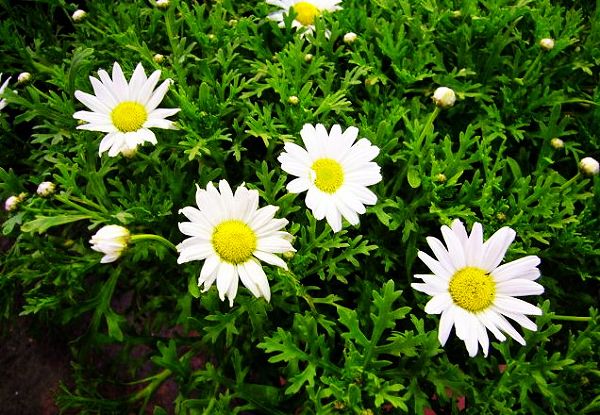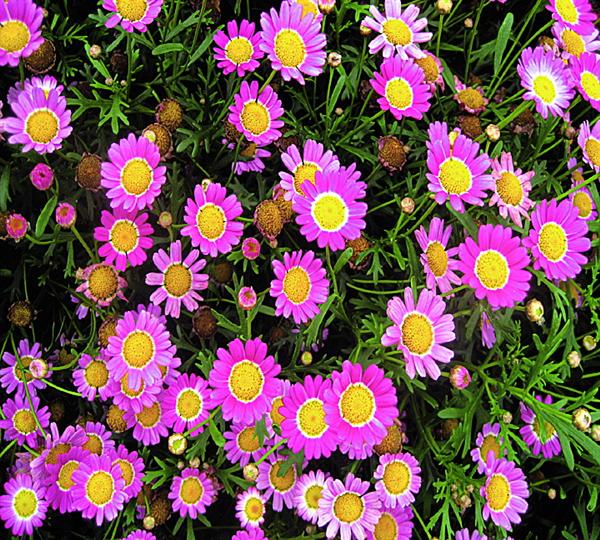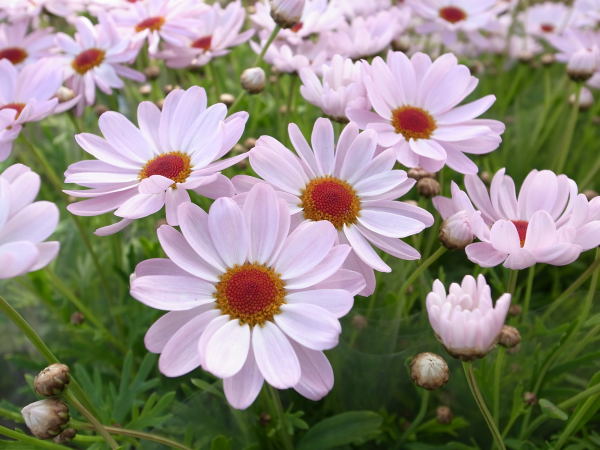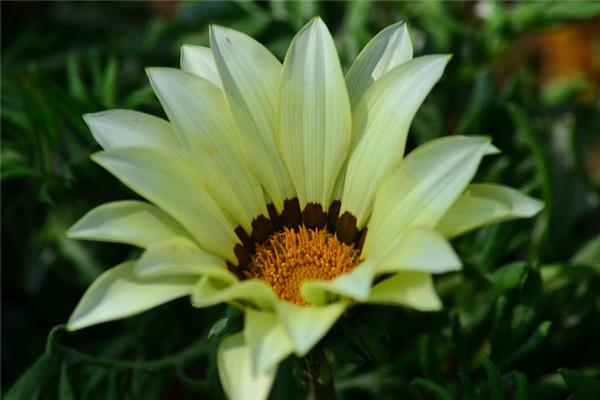Culture methods and matters needing attention of Chrysanthemum morifolium
Penghao chrysanthemum, also known as Marguerite, is now a very common kind of floret, we raise at home is also very easy, after the flower is very lovely. Today, the editor will tell you about the breeding methods and matters needing attention of Artemisia annua.

Brief introduction of Chrysanthemum morifolium
Aliases: chrysanthemum, oriental chrysanthemum, Margaret
Scientific name: Chrysanthemun frutescens
Families and genera: Compositae, Compositae
Origin: Canadian Islands
Perennial herbs or subshrubs, plant height 60-100 cm, whole plant smooth glabrous, much branched, stem base lignified, single leaves alternate, irregular bipinnately parted, lobes linear, lower leaves Obovate-lanceolate, base attenuate into long stalks, middle leaves oblong to lanceolate, tip pointed, base slightly narrower, upper leaves smaller, lanceolate or linear-lanceolate, heads inserted in upper leaf axils, pedicels longer. Ligulate flowers 1-3 whorls, white or yellowish, tubular flowers yellow, diaphragm crown of crown hairs, dentate or shortly Awned. The anniversary of florescence, the full bloom from April to June.
Chrysanthemum morifolium is an evergreen subshrub plant of Compositae. Like cool and humid climate, can not bear the heat, especially avoid the strong sun in summer, there must be shade in summer, avoid stagnant water, also not resistant to drought, high-temperature summer, should often implement foliar spray to moisturize. The stem contains the Lignification relationship, so it is named Chrysanthemum, and because the plant will emit a special flavor similar to that of Artemisia "that is, Artemisia", it is called Chrysanthemum.

Culture methods and matters needing attention of Chrysanthemum morifolium
First, soil, Penghao Chrysanthemum likes loose, fertile, well-drained soil.
Soil: 5 black mountain soil and 5 peat soil. If there is no black mountain soil, you can use garden soil instead.
Second, it seems that the chrysanthemum does not bear seeds, and its reproduction mainly depends on the cuttings.
Generally, a covered seedling box is used to insert, and the soil is peat soil plus vermiculite, or peat soil plus perlite. The best season is spring and autumn, and the other two seasons are also easy to survive. The cuttings are kept on the balcony all the time, and the lid of the seedling box is covered in the other three seasons except in summer, which can keep the water and heat preservation and improve the survival rate of the cuttings. It is inserted directly in the flowerpot in summer because the seedling pot is too small and the water is easy to evaporate.
Third, fertilizer, generally apply sufficient base fertilizer when changing pots and planting, and no longer apply fertilizer in other periods. Chicken manure and a small amount of slow-release fertilizer are used for base fertilizer. Since chicken manure is ripe, it doesn't matter to have a little more. The amount of slow-release fertilizer must be controlled according to the size of the basin. The most important point is that the root cannot come into contact with the fertilizer. Occasionally chase some fertilizer during the flowering period, using "must blossom".
Fourth, the environment, artemisia chrysanthemum has been kept in the balcony, it will not spend too much time in direct sun in summer. In winter, a few pots that focus on conservation will be put out of the rain.

Fifth, pruning, generally do not prune the chrysanthemum, only cut short the particularly long branches at the seedling stage.
Sixth, how to turn the chrysanthemum into a ball. Ma, who has just survived the first year of her life, will not grow into a very tight ball. After the extreme heat in summer and the severe cold in winter, Ma can easily grow into a very tight ball. We should pay attention to that many leaves may dry up after summer and winter, as long as there is still green in the center of the branches, do not discard them, generally maintain and water them, and arrange the withered leaves in March or April of the next year and apply fertilizer in pots. Ma will soon grow very close branches and buds, and the volume will be more than 3 or 4 times the original.
Sunshine is also very important. Sunshine and rain are the best nourishment for plants.
The Flower language of Penghao Chrysanthemum
The flower language and symbolic meaning of Penghao chrysanthemum and oriental chrysanthemum: pride, satisfaction, joy.

Chrysanthemum morifolium is also known as chrysanthemum, oriental chrysanthemum and Artemisia annua. The flowering period of oriental chrysanthemum is usually between winter and spring, because the stem of its old plant will slowly change into Lignification, so it is also called Artemisia annua. Artemisia annua will soon wither or even die once it is damaged by frost in winter, so when winter comes and the cold current comes. Potted Artemisia annua should be moved to a warm room to avoid the cold, while those planted in the ground should be covered with straw to prevent frost. This is the only way to make it through the winter smoothly.
The origin of the flower language about it comes from a legend. According to legend, as long as you hold the chrysanthemum and oriental chrysanthemum in your hand, and when you pick off the leaves of the chrysanthemum, you should read: love, don't love, love, don't love. When you count the last leaf, you can make divination about the love between you and him.
Propagation and cultivation of Chrysanthemum morifolium
Chrysanthemum chrysanthemum is propagated with chrysanthemum, which can be carried out in spring and autumn, and the specific time is generally determined according to the requirement of flowering time. It blossoms from September to October, May 1st of the following year, June to July of the following year, and early spring of the following year. Cuttings choose mature and robust branches. At the temperature of 20-24 ℃, it took root for about 2 weeks. When the seedling height is 10-15cm, the heart can be removed to promote its branching. After planting seedlings in September, potted plants can be planted in November and kept in the greenhouse for maintenance. At the initial stage of growth, light fertilizer can be applied several times, and later, depending on the growth situation, thicker topdressing can be added. After May, the weather is getting hotter and the leaves begin to wither and yellow. at this time, we should gradually reduce watering, cut off the upper branches and leaves, and move out of the room from July to August. Plants planted in the land should pay attention to drainage and waterlogging prevention in the rainy season.

The above content is our introduction about the breeding methods and matters needing attention of the chrysanthemum, how about, is it easy to breed the chrysanthemum? If you like it, why don't you raise some yourself.
And when you pick the leaves of the chrysanthemum with your heart, you should read: love, do not love, love, do not love. When you count the last leaf, you can make divination about the love between you and him.
Propagation and cultivation of Chrysanthemum morifolium
Chrysanthemum chrysanthemum is propagated with chrysanthemum, which can be carried out in spring and autumn, and the specific time is generally determined according to the requirement of flowering time. It blossoms from September to October, May 1st of the following year, June to July of the following year, and early spring of the following year. Cuttings choose mature and robust branches. At the temperature of 20-24 ℃, it took root for about 2 weeks. When the seedling height is 10-15cm, the heart can be removed to promote its branching. After planting seedlings in September, potted plants can be planted in November and kept in the greenhouse for maintenance. At the initial stage of growth, light fertilizer can be applied several times, and later, depending on the growth situation, thicker topdressing can be added. After May, the weather is getting hotter and the leaves begin to wither and yellow. at this time, we should gradually reduce watering, cut off the upper branches and leaves, and move out of the room from July to August. Plants planted in the land should pay attention to drainage and waterlogging prevention in the rainy season.

The above content is our introduction about the breeding methods and matters needing attention of the chrysanthemum, how about, is it easy to breed the chrysanthemum? If you like it, why don't you raise some yourself.
Related
- Wuhan Hospital Iron Tree Blooming Result Was Instantly Frightened by the Gardener Master
- Which variety of camellia is the most fragrant and best? Which one do you like best?
- What is the small blue coat, the breeding methods and matters needing attention of the succulent plant
- Dormancy time and maintenance management of succulent plants during dormancy
- Minas succulent how to raise, Minas succulent plant pictures
- What are the varieties of winter succulent plants
- How to raise succulent plants in twelve rolls? let's take a look at some experience of breeding twelve rolls.
- Attention should be paid to water control for succulent plants during dormant period (winter and summer)
- Watering experience of twelve rolls of succulent plants
- Techniques for fertilizing succulent plants. An article will let you know how to fertilize succulent plants.



